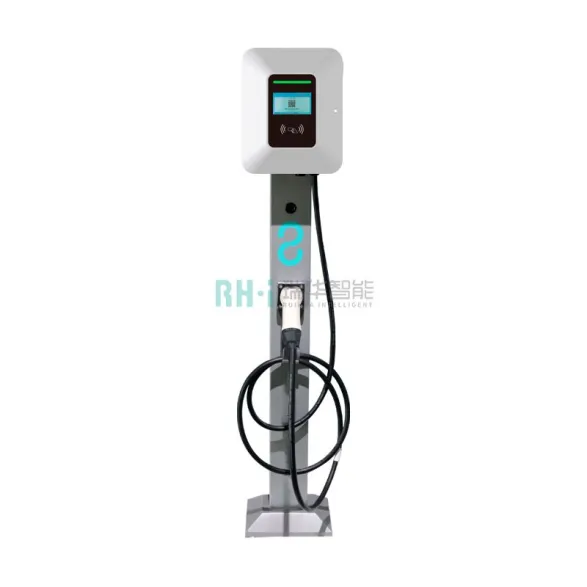Best 48 AMP EV Charger: Fast Charging Solution for Your Electric Vehicle
Efficient charging solutions are becoming a major requirement for businesses and fleet operators. 48 Amp EV Chargers are high-performance EV charging solutions customized for business needs. High quality and super fast charging! Ensures minimal EV downtime, it charges up to 11.5 kW (single-phase connection) to significantly reduce charging time without compromising safety or performance.

Do I Need the 48 Amp EV Charger?
Electric vehicles usually come with a charging cable supplied by the manufacturer. But these chargers are not universally applicable, and the charging power varies considerably from brand to brand and even from product line to product line of the same manufacturer.
Even for the same brand of electric car, the charging equipment that comes with it can vary from model to model. Some of them come with Level 2 (Level 2) chargers – a powerful device that uses 240 volts. Their efficient performance allows you to fully charge your battery while you sleep, typically providing a range of 10 to 20 miles per hour.
On the other hand, the default chargers offered by many automakers are Level 1 chargers, which are designed to work with standard household 120-volt outlets. These trickle chargers are significantly slower to charge than Level 2 chargers, and typically provide only about 3 miles of range per hour. Level 1 chargers are typically better suited for PHEVs, which have smaller batteries, typically between 5 and 20 kWh, compared to pure electric vehicles, which typically have batteries between 60 and 100 kWh.
So, the key question here is: do I need the 48 amp EV charger if the charger provided by the manufacturer is sufficient for my new EV?
The best way to answer this question is to check if the default charger can fill the battery overnight. If it does, then you don’t need a 48 amp charger.
But if not, purchasing a 48 amp charger would be a wise choice.
Keep in mind, however, that all Level 2 chargers require a 240-volt outlet, so if your garage or other charging location doesn’t already have one, be sure to install one!

How to Install the 48 Amp EV Charger?
The Amp Headroom and the Separate Circuit
Due to the higher power of a 48 amp EV charger, having a dedicated circuit for it is the recommended practice. This ensures that the charger operates without interference from other appliances, increasing charging efficiency and safety.
Depending on safety regulations, 48 Amp EV chargers require a larger margin to handle power surges, so a separate 50 or 60 Amp circuit is recommended. This is to ensure that there is enough capacity to handle possible surges during charging, as well as to ensure stable charging. For reference, a standard 32 amp charger requires a 40 amp circuit.
Safety regulations: According to the Safety Requirements and Test Specification for Electric Vehicle Power Supply Equipment GB/T39752-2021, the safety requirements, test guidelines and test methods for electric vehicle power supply equipment are clearly defined, including the rated output voltage of the charging equipment and charging mode.
Surge Protection: Existing international technical standards must be used to select the correct Surge Protection Device (SPD) configuration and its associated ratings for the EV infrastructure. Especially in buildings not protected by a lightning protection system, each EVSE (Electric Vehicle Supply Equipment) requires an additional Class 2 SPD, unless the distance from the main panel to the EVSE is less than 10 meters.
48 Amp EV Charger: the Installation Process
48 amp EV chargers are hard-wired devices and require permanent installation by a professional. For 48 amp EV chargers, it is recommended to use 6 gauge (AWG) cable, which is thicker and capable of carrying more current. And for safety reasons, it is recommended that the charger be connected to a 60-amp circuit breaker. This is because safety codes typically require circuits to be rated at 25% higher current than the charger’s output to ensure safe operation in all situations.
It is highly recommended to hire a licensed electrician to perform the installation, as Level 2 EV chargers involve high power and require specialized knowledge to ensure the installation meets electrical safety standards.
Notes:
- Proper installation is essential to protect your EV, charger, and your entire home electrical system. Improper installation can lead to electrical fires or other safety issues.
- Ensuring that the installation process complies with local electrical codes and safety standards is critical to avoiding future problems and potential liability.
Where to Install My 48 Amp EV Charger?
The 48 Amp EV charger should be installed in a location where the charging cable can easily reach your EV charging interface for a convenient connection to your electric vehicle. Additionally, the installation location needs to be dry and ventilated to avoid humid environments, as well as avoiding exposure to rain or splashing water. If installing in a garage, make sure it is close to the electrical panel to provide the charger with the required 60-amp circuit.
The charger should be mounted at an easily accessible height, typically 4 to 6 feet above the floor, for easy connection and disconnection of cables. Comply with local building and electrical codes to ensure safety and regulation. If unsure, consult a professional electrician for installation.
Tips for Using Your 48 Amp EV Charger the Right Way
By following these tips, you can ensure that your 48 amp EV charger is used safely and efficiently, prolonging the life of both your charger and your electric vehicle’s battery.
Here are some key tips to have in mind:
- Mind the connector: When not in use, keep it holstered in its designated spot to shield it from dirt and moisture.
- Coil up the cable: When the charge is complete, neatly coil it to prevent accidental run-overs.
- Connector safety: Don’t leave the connector sprawled on the ground.
- Cost-efficiency: Schedule charging during off-peak hours.
- Storm protection: Lightning indeed strikes fear, so make sure to unplug your charger during electrical storms to avoid any potential damage.
Maximising Battery Mileage
Electric vehicle manufacturers recommend not charging the battery to 100% too often, as this may accelerate battery aging. Try to keep the battery between 20% and 80% or 80% and 100%, which can help extend battery life. Utilize your vehicle’s smart charging features to set a charging cutoff point, such as 80%, to avoid overcharging.
Many car owners are concerned that continuing to plug their charger into the car after reaching the target charge level will result in overcharging. However, modern electric cars and chargers are equipped with a battery management system (BMS) that automatically stops the charger from supplying power once the battery is full. So don’t worry about overcharging; you can leave it plugged into the car for as long as you need.
Finally, while it is recommended to avoid frequent full charging in daily use, periodically (e.g., once a month) charging the battery to 100% can help calibrate the battery and ensure accurate readings from the battery management system. And, if the vehicle supports it, use the Battery Pretreat feature to preheat or pre-cool the battery before departure to improve efficiency and range.
Breaking Down Circuit Breaker Ratings
Circuit breakers have different ratings, so it is critical to understand what “Power Delivery (kW),” “Maximum Output (Amps),” and “Circuit Breaker (Amps)” mean, and why they are important. It’s critical.
Let’s break it down.
- Power delivery (kW): Ranges from 2.8 to 19.2 kW.
- Maximum output (amps): Varies between 12 and 80 amps.
- Circuit breaker (amps): Ranges from 15 to 100 amps.
It is highly recommended to match the 48 amp EV charger rating to the correct circuit breaker amperage as this will greatly affect the speed at which your EV charges.
Is the 48 Amp EV Charger Fast Enough?
In short: Yes. But let’s break it down from different angles and with some numbers.
Plug-in Hybrid Electric Vehicles (PHEVs), for example, have a smaller battery capacity. They typically require a lower current for charging, around 16 amps, which is perfectly adequate for shorter electric ranges.
However, pure electric vehicles (EVs) are equipped with more powerful batteries for maximum electric range and therefore require more energy intake. Modern EVs are designed to be charged at 30 to 48 amps, depending on the model.
Here’s a handy table for understanding how much range different EV chargers can provide and how long it will take to charge two types of electric vehicles: the Chevrolet Bolt EV (65 kWh battery) and the Tesla Model S (100 kWh battery). The table specifies the power output in kilowatts (kW), the range added per hour, and the average charging time from flat to full.
| POWER DELIVERY (AMPS) | POWER DELIVERY (KW) | RANGE ADDED PER HOUR | 100 KWH BATTERY CHARGE TIME FROM 0% | 60KWH BATTERY CHARGE TIME FROM 0% |
| 48-amps (240-volt) | 11.5 kW | 34-46 miles | 9 hours | 5.5 hours |
| 40-amps (240-volt) | 9.6 kW | 29-38 miles | 10.5 hours | 6.5 hours |
| 32-amps (240-volt) | 7.7 kW | 23-31 miles | 13 hours | 8 hours |
| 16-amps (240-volt) | 3.8 kW | 11-15 miles | 26.5 hours | 16 hours |
| 12-amps (120-volt) | 1.4 kW | 4-5 miles | 72 hours | 43 hours |
Easy to find charging stations: RUIHUA app helps electric car owners
As an electric vehicle owner, we all know that finding an available charging station can often be a headache. To solve this problem, the RUIHUA app was created to simplify your charging experience and eliminate those unnecessary hassles.
We’ve partnered with a robust public charging network to provide real-time charging station information so you can enjoy the following services:
- Access to thousands of charging points
- Transparent and easy pricing
- Innovative features
- Easy-to-use interface
The app will guide you directly to the nearest charging station and help you get there faster with simple navigation (Waze, Google Maps and Apple Maps supported), taking into account station availability, charging speed and even cost.
